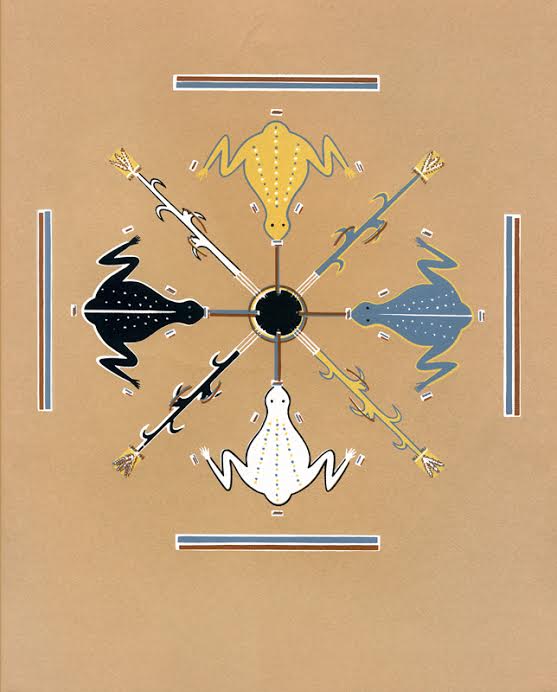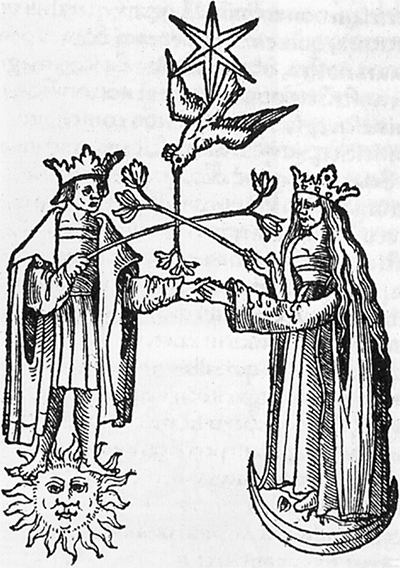ARAS Connections
Image and Archetype

Welcome
by Tom Singer
Over the course of more than a decade (1985-1998), Joe Henderson gave a series of lectures to the San Francisco Jung Institute Friends of ARAS. Dr. Daniel Benveniste attended all of the lectures and kept careful notes of Dr. Henderson’s remarks. He collected these detailed summaries in an unpublished manuscript entitled “Thinking in Metaphor”. Recently, Dr. Benveniste graciously gave his permission to publish his transcripts of these lectures and this edition of ARAS Connections features the second lecture that we are publishing in that series-- “On the Rosarium Philosophorum”. We intend to publish the series in full over time, one lecture at a time. Dr. Henderson emphasizes throughout these lectures that “most symbols appearing in dreams or waking fantasies are still in a process of formation and if we speak of them as known, fixed images, we rob them of their creative potential.” Kako Ueda, the curator of ARAS, has undertaken the supervision of this project and she will be assisted by others who will help in the editing of the commentary and the selection of images to bring to life the written accounts.
Gary Astrachan’s “Self-Portraits” takes us on a breathtaking journey that begins with a short description of the last fifteen minutes of Frederick Wiseman’s documentary film, National Gallery. Astrachan’s exploration of “poesis” and the nature of seeing and being seen, of the visible and invisible is a stunning romp that is at times ecstatic. The rapturous, unbridled flow of his narrative actually induces the kind of vision that Astrachan helps us see through the eyes of Rembrandt’s final self-portrait painted in 1669. He writes, “Rembrandt’s eyes have this capacity to rip off the veil of ordinary looking to reveal an other world, a world of seeing through appearances, beyond surfaces, to the perpetual otherness of the world, to “the other of all worlds, that which is always other than the world” (Blanchot 1982, p.228). I must confess that this is one of the more radical and thrilling essays that we have published in ARAS Connections.
Perhaps in the same spirit of Astrachan’s exploring the visible and invisible in Self-Portraits, Rachel McRoberts takes us on her own unique journey in “The White Rabbit: Sacred and Subversive.” She writes, “I have often remarked over the years that the spirit of the White Rabbit guides my life, pulling me with curiosity, like Alice, to my next adventure. Now approaching midlife, transitioning personally and professionally, it seems fitting to deeply visit the White Rabbit, taking yet another dive “down the rabbit hole”. Her amplification of the symbol of the White Rabbit is wide ranging and multivalent as she writes: “Cultures around the world have told stories of these “paradoxical creatures: symbols of both cleverness and foolishness …of rampant sexuality and virginal purity”, masculine and feminine energy at once, the “wily deceiver and sacred world creator rolled into one” (Windling, 2020) since the beginning of time.”
On the Rosarium Philosophorum
by Daniel Benveniste, Ph.D. in collaboration with Joseph L. Henderson, M.D.

The Rosarium Philosophorum is an alchemical text ascribed to Petrus Toltetanus of Toledo in the mid-1200s. The only version available to us now was printed in 1550. It is a text, which describes and illustrates the alchemical process of psychic transformation through the metaphor of the sexual union of the King and Queen and their subsequent physical transformations. This process is presented in a series of 20 woodcuts with associated commentaries. In 1946 C.G. Jung published The Psychology of the Transference using the first half of the series from the Rosarium Philosophorum to illustrate the typical stages in the development of the transference in psychotherapy. On March 18th, 1990 Joseph L. Henderson gave a slide and lecture presentation before the S.F. Friends of ARAS using the second half of the series to illustrate further developments in the transference and individuation process. He illustrated his presentation with a colorful set of paintings accurately reproducing the original 1550 woodcuts. He began with a review of Jung's commentary on the first ten slides and followed this up with his presentation of the second half of the series. This article is a summary of Dr. Henderson's presentation. I will begin with my own brief introduction to Dr. Jung's discussion on the first ten woodcuts and follow this with my summary of Dr. Henderson's presentation.
To read On the Rosarium Philosophorum in its entirety, click here.
Self-Portraits
by Gary D. Astrachan

Abstract: This paper originates in the primal experience of being seen that may occur while standing in front of a late self-portrait by Rembrandt. A close analysis of the last fifteen minutes of Frederick Wiseman’s documentary film, National Gallery, which concludes with an image of Rembrandt’s next-to-last self-portrait from 1669, leads to an exploration of the very nature of vision itself. What is visibility and where does it come from? In the world of things, who is seeing whom? Themes of looking, seeing and being seen, as well as the transgressive and therefore punishable gaze, are taken up in the contexts of Western art and Greek mythology in the attempt to determine the boundaries, borders and limits of vision itself. The author suggests that vision is a streaming function of the objective psyche in its individuating aspect, and that nature and matter are continuously seeing us in order that we may fulfill their deeper strivings towards wholeness.
Key words: art, mythology, vision, the invisible, nature, matter, being seen.
In the final scene of the documentary film, National Gallery, there is a contemporary dance performance staged in a room of the museum where the exhibit, Metamorphosis: Titian, is on display. It is 2012. After a silent pas de deux prelude, baroque music by the sixteenth century composer William Byrd begins to play.
From the opening shot of the sequence, the performer, at first a single young female, shortly joined by a male dancer who gracefully circles her for a duet, stands perfectly straight in profile in the center of the screen, hieratic and supple. She is flanked by two renditions of the myth of Diana and Actaeon painted by Tiziano Vecellio, called Titian. On the left hangs the earlier Diana and Actaeon, painted between 1556 and 1559, which depicts the tragically-doomed, handsome young hunter as he unwittingly comes upon the magnificent virgin goddess Diana at her bathing pool attended by several of her handmaidens. In the painting, a startled Actaeon is parting a slight red curtain to reveal the pale golden flesh of the grand huntress goddess. She casts him a sharp, penetrating glance while partially obscuring her own face protectively with her arms.
To read Self-Portraits in its entirety, click here.
The White Rabbit: Sacred and Subversive
by Rachel McRoberts
 Abstract: This piece addresses personal and collective symbolism surrounding the White Rabbit. Through descriptions of associative and analytic modes of thought, in artwork, sandplay, and research from a post-modern, feminist perspective, the author explores this symbol up, down, and through, paralleling Alice’s dream state adventures and adding to the body of literature on the White Rabbit, curiously absent in the field of sandplay.
Abstract: This piece addresses personal and collective symbolism surrounding the White Rabbit. Through descriptions of associative and analytic modes of thought, in artwork, sandplay, and research from a post-modern, feminist perspective, the author explores this symbol up, down, and through, paralleling Alice’s dream state adventures and adding to the body of literature on the White Rabbit, curiously absent in the field of sandplay.
Keywords: white rabbit, symbol, sandplay, feminist, mid-life, subversive, literature, curious, Alice, Wonderland, Jung, Kalff, Nietzsche
The White Rabbit: Sacred and Subversive
The White Rabbit has always been a symbolic companion of mine. Since I was a child, I have collected Alice in Wonderland and Through the Lookingglass (Carroll, 1865/1871/1960) memorabilia, most of it given to me as gifts from loved ones. From porcelain figurines and embellished teacups, to indie theater posters and interpretations in perfumery, White Rabbits dot my home and studio (see Figures 1- 3).
I have often remarked over the years that the spirit of the White Rabbit guides my life, pulling me with curiosity, like Alice, to my next adventure. Now approaching mid-life, transitioning personally and professionally, it seems fitting to deeply visit the White Rabbit, taking yet another dive “down the rabbit hole”.
Preparing for A Reintroduction
Having spent the past few years intensely engaged in earning my Ph.D. in counselor education and supervision, where I engaged in a personal sandplay process and studied the creativity in sandplay therapists for my dissertation (McRoberts, 2020), I found my life in transition. During the COVID-19 pandemic I had reached my terminal degree, and both my children had graduated from high school. It seemed strange to be reaching such milestones while cloistered in lockdown, not unlike a rabbit’s clutch. With encouragement from beloved mentors, I decided to begin writing my first symbol paper towards certification as a sandplay therapist through the Sandplay Therapists of America (2019). However, I felt a bit stuck creatively, psychically, and in writing about my beloved symbol. While so powerful and dear to me emotionally, when I attempted to write, my thoughts and words were jumbled, so I avoided it for some time. I was aware, through my recent creativity research, that I had been over exercising my analytic mode of thought, and held my associative processes in a sacred space that was somewhat intimidating to transverse alone, especially in the early stages of creation here.
To embrace the White Rabbit fully, I knew I needed to let go. But I knew that by following the White Rabbit, I, like Alice, would be, to a degree, abandoning my traditionally accepted studies, my older sister/teacher/self, and the life that I knew.
To read The White Rabbit: Sacred and Subversive in its entirety, click here.